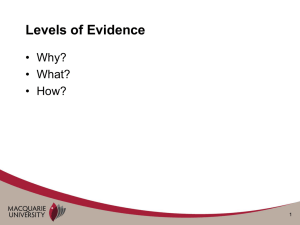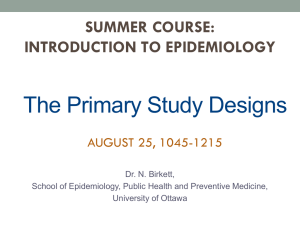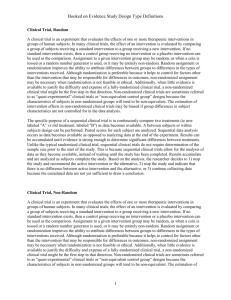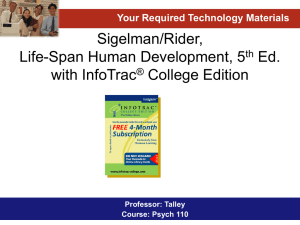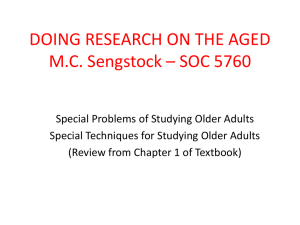Click here to view slides
advertisement
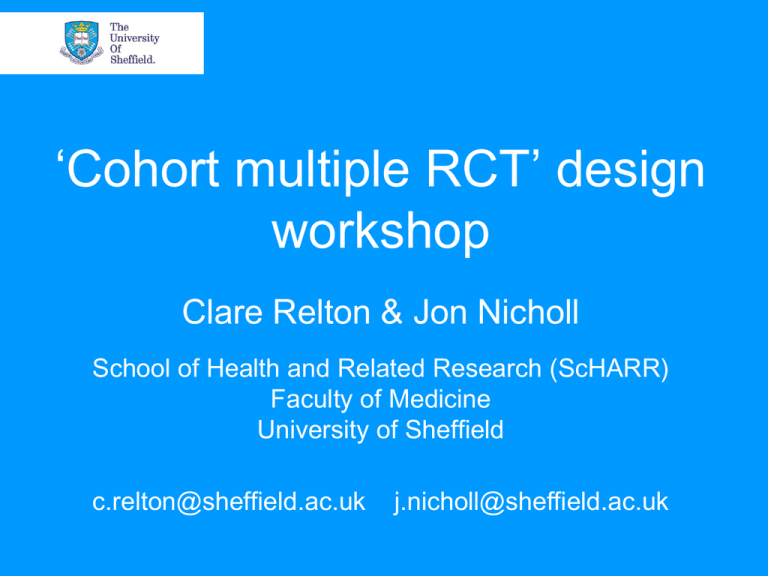
‘Cohort multiple RCT’ design workshop Clare Relton & Jon Nicholl School of Health and Related Research (ScHARR) Faculty of Medicine University of Sheffield c.relton@sheffield.ac.uk j.nicholl@sheffield.ac.uk Purpose of workshop • Share knowledge, experiences and ideas Programme 10.35 Introduction to the cmRCT design 11.00 Current research using the design 12.25 Panel Q&A 12.40 LUNCH 13.40 How to analyse cmRCTs 13.50 Talking Circles I & II (35 mins each) 15.00 Tea/coffee 15.20 Plenary feedback/ Panel discussion 16.30 End Housekeeping • Exits • Loos • Name • No mobiles • Workshop information • Talking circle topics Backstory Introduction to cmRCT design • Problems with standard designs • cmRCT design defined • Differences with other designs • Benefits • Most suited to..... Pragmatic trials • ‘pragmatic’ first applied to clinical trials by Schwartz & Lellouch (1967) who made the distinction between: • explanatory trials (which aim to further knowledge as to how and why) • pragmatic/practical trials (which aim to inform healthcare decisions within routine practice). Problems with standard designs • poor recruitment rates – implications for cost, validity, reliability, comparability of the results • informed consent barrier to recruitment (Ross, 1999) • unrepresentative recruited population • patient & clinician treatment experiences altered • lack of long term outcomes • poor external validity.... Components of cmRCT • *1 Cohort • * 2 Random selection • * 3 Informed consent – patient centred * 1: Cohort • Recruit observational cohort of patients • Regular outcome measurement for whole cohort * 2: Random selection • Capacity for multiple RCTs over time • For each RCT • eligible patients identified from which some randomly selected to be offered the intervention • Outcomes of randomly selected patients compared to not randomly selected. * 3: Informed consent • Patient information and consent replicate real world routine healthcare i.e. patients are not told about treatment that they might not receive ‘Cohort multiple RCT’ design Relton, Torgerson, O’Cathain & Nicholl. BMJ 2010;340:c1066 Copyright ©2010 BMJ Publishing Group Ltd. Based on (Zelen) randomised consent design • Reviews: Schellings 2006, Adamson 2006 10/04/2015 Differences: cmRCT & other designs *1: Cohort *2: Randomisation *3: Informed Consent – patient centred *1. Cohort • Characterised/ phenotyped population’ • Contacted again • Use their data comparatively • Access to routine health records • Facility for multiple trials *2. Randomisation Something that is ‘done’ to everyone? Random allocation of all Or Random selection of some *3. Informed Consent Memory research • Many people suffer from poor memory and there are few treatments available • However, US research has found that as well as helping lower blood pressure (Buitrago-Lopez 2011), chocolate (epicatechin) can boost memory in mice particularly when combined with exercise. University of Sheffield researchers are now planning a study to measure the effectiveness of chocolate on memory. • We (researchers) are looking for people to participate in this research. If you decide to participate you will be asked to provide information about your general health and physical activity (using an online form) and asked to perform a short online memory test once a week for 6 weeks. • We are not sure if chocolate is more effective than no chocolate. • Participants will be randomly selected to receive either chocolate or no chocolate *3. Informed Consent Patient centred • Replicates procedures in routine healthcare • Patients not told about treatments that they are not then offered • Patients not told that their treatment will be chosen ‘at random’ Type and timing of information (standard RCT design) (I) There is a treatment and the benefits are… the risks are … 10/04/2015 (II) …and there is research ongoing… (III) … and we want to observe you…. (IV) …and we are not sure which treatment is best…. (V) …and we are going to play a game of chance’… Type and timing of information: ‘patient centred’ as used in ’cmRCT’ design (III) … and we want to observe you…. (II) …there is research ongoing… 10/04/2015 (I) There is a treatment and the benefits are… the risks are … (IV) …and we are not sure which treatment is best…. (V revised) …and you have been selected at random to try it.... Benefits of ‘cohort multiple RCT’ approach • Recruitment – improved quantity and more representative sample • multiple RCT facility • long term outcomes as standard • ongoing information as to the natural history of the condition and treatment as usual • increased comparability between each trial conducted within the cohort • increased efficiency, particularly for expensive or high risk interventions (unequal randomisation) Opportunities • Open trials with ‘treatment as usual’ as comparator • Easily measured & collected outcomes • Clinical conditions where many trials will be conducted • Chronic conditions • Highly desired treatments or expensive treatments Least suited to.. • Closed trial designs with masking or placebo arms • Research questions with hard to measure and hard to collect outcomes • Acute or short term conditions Examples • Ongoing • Funded Talking circles • Your topics • Facilitator • Report back: • Issues discussed • Conclusions reached • Actions required Thank you • Speakers • Brett Thombs • Kate Thomas • CLAHRC – SY • Sue & Emily


